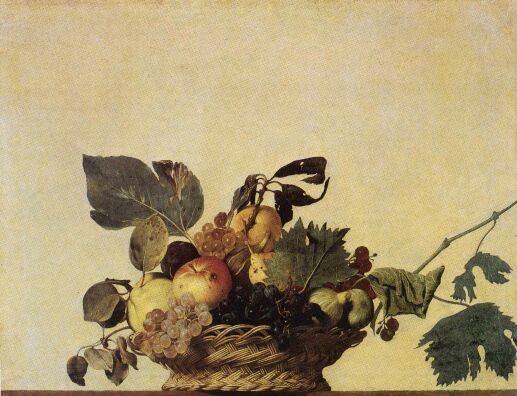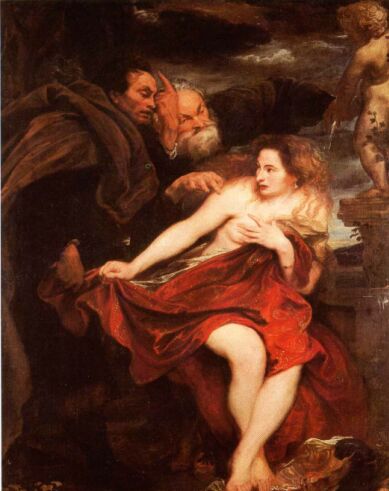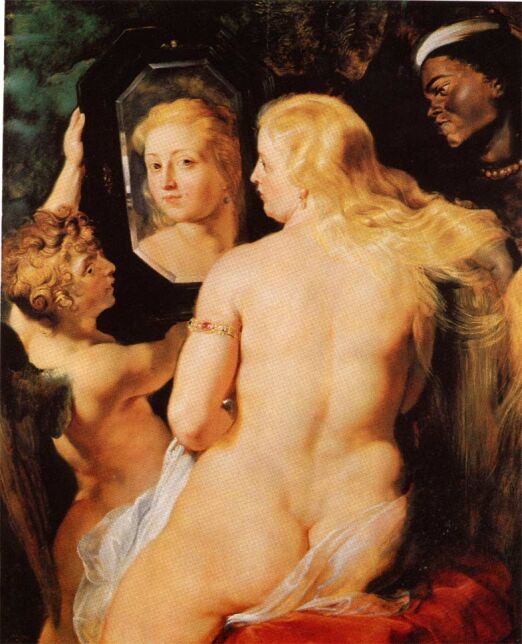on baroque paintings
In paintings as well as in poetry, similar topics are dealt with. We want to introduce three pictures of famous European painters, which we saw in the "Alte Pinakothek" in Munich.
Joy of life and lust of love which seem to be promised in Rubens´ "Toilet of Venus" quickly turn into their opposite when they become a threat as they do in van Dyck´s "Susanna and the Elders". Van Dyck`s topic is obviously that of untouchable purity – a popular topic of the baroque that also appears in the love poems which we worked with. In any case, love – be it in paintings or in poetry – is a dramatic and often rather violent spectacle. To understand it better, it helps if you know something about ancient mythology and about the old stories in the bible.
With his "Fruit Basket" Caravaggio shows another basic idea of this epoch: the transitoriness of all things on earth.

Caravaggio (1573-1610): "Fruit
Basket"
Caravaggio`s "Fruit Basket" was painted in 1596. It is a so-called "Vanitas still life". At first sight it seems to show a most delicious "Fruit Basket", but if you took a closer look, you can notice that the leaves are withering and the fruit are rotting.
This picture expresses that everything in life is transitory. This way of looking at things can be explained by the fact that the people in that age were as exposed to the horrors of war and diseases as to the beauties of life. On other still lives, too, there are always symbols of death and pain mixed with the symbols of love and luxury, as e.g. when skulls are decorated with roses.

Anthonis van Dyck (1599-1641):
"Susanna and the Elders"
This picture was painted in 1621. Anthonis van Dyck, born 400 years ago, was the most famous pupil of Rubens and, apart from Rubens, the most famous Flemish painter. The picture "Susanna and the Elders" was painted during van Dyck´s stay in Italy which lasted until 1627.
This picture is based on a story in the Old Testament: Susanna takes a bath in her garden with two lusty old men first observing and then molesting her. When she rejects them, they threaten to accuse her of adultery. On the picture you can clearly see Susanna´s protest. That shows that she wants to save her purity at any price.
Typical of baroque painting is that the most important person, Susanna in this case, is presented with all the light on her while the men remain in the dark. Susanna is moving backwards to avoid the threat and it seems as if escaping into the direction of the viewer were the only chance she had.

Peter Paul Rubens (1577-1640):
"Toilet of Venus"
The picture "Toilet of Venus" was created in 1615.
Peter Paul Rubens was the most famous artist of the epoch. Seen from today´s point of view, particularly if you are a young viewer, his extreme way of presenting rather big naked women – his idea of beauty - can be rather repelling.
This Venus is a big lady, too. She is sitting naked on a bench and you see her back covered by a transparent veil only. Long golden curls decorate her head. She has turned her head to the left. What is really rather clever is that we see both her profile and her face, because her face is reflected in the mirror which Amor holds up for her. Surely, her back must have been the very essence of feminity and thus highly seductive for the viewer of the 17th century. The fact, however, that this Venus is a very intelligent, superior and probably also a rather icy woman, can be seen from her cold eye in the reflection in the mirror.
The background of the picture is so blurred that you cannot see whether the persons are in a room or in nature – the Goddess of Love seems to be everywhere. As in van Dyck´s paintings, the main person is in the light again. Every move in the picture is directed towards her reflection in the mirror. The jewellery on her ear and arm symbolizes her wealth - nobody will dare do this woman any wrong.
Elisabeth Schallhart, Claudia Ruch